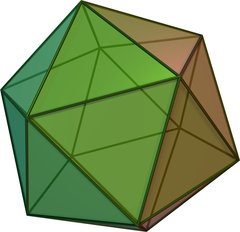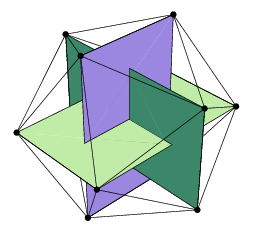Icosahedron
|
|
| Icosahedron | |
|---|---|
 Click on picture for large version. Click here for spinning version. | |
| Type | Platonic |
| Face polygon | triangle |
| Faces | 20 |
| Edges | 30 |
| Vertices | 12 |
| Faces per vertex | 5 |
| Vertices per face | 3 |
| Symmetry group | icosahedral (Ih) |
| Dual polyhedron | dodecahedron |
| Properties | regular, convex |
| Dihedral Angle | 138.1896852° |
An icosahedron [ˌaıkəsə'hiːdrən] noun (plural: -drons, -dra [-drə]) is a polyhedron having 20 faces. The faces of a regular icosahedron are equilateral triangles. [Etymology: 16th Century: from Greek eikosaedron, from eikosi twenty + -edron -hedron], "icosa'hedral adjective
Missing image
Icosahedron_flat.png
image:icosahedron flat.png
In geometry, the regular icosahedron is one of the five Platonic solids. It is a convex regular polyhedron composed of twenty triangular faces, with five meeting at each of the twelve vertices. It has 30 edges. Its dual polyhedron is the dodecahedron.
The area A and the volume V of a regular icosahedron of edge length a are:
- <math>A=5\sqrt3a^2<math>
- <math>V=\begin{matrix}{5\over12}\end{matrix}(3+\sqrt5)a^3<math>
There are distortions of the icosahedron that, while no longer regular, are nevertheless vertex-uniform. These are invariant under the same rotations as the tetrahedron, and are somewhat analogous to the snub cube and snub dodecahedron, including some forms which are chiral and some with Th-symmetry, i.e. have different planes of symmetry than the tetrahedron. The icosahedron has a large number of stellations, including one of the Kepler-Poinsot solids and some of the regular compounds, which could be discussed here.
Many viruses, e.g. herpes virus, have the shape of an icosahedron. Viral structures are built of repeated identical protein subunits and the icosahedron is the easiest shape to assemble using these subunits. A regular polyhedron is used because it can be built from a single basic unit protein used over and over again; this saves space in the viral genome.
In several roleplaying games, such as D&D, the twenty-sided die (for short, d20) plays a vital role in determining success or failure of an action.
If each edge of an icosahedron is replaced by a one ohm resistor, the resistance between opposite vertices is 0.5 ohms, and that between adjacent vertices 11/30 ohms.
Icosahedron vs dodecahedron
Despite appearances, when an icosahedron is inscribed in a sphere, it occupies less of the sphere's volume (60.54%) than a dodecahedron inscribed in the same sphere (66.49%).
See also
External links
- The Uniform Polyhedra (http://www.mathconsult.ch/showroom/unipoly/)
- Virtual Reality Polyhedra (http://www.georgehart.com/virtual-polyhedra/vp.html) The Encyclopedia of Polyhedra
- [1] (http://www.tulane.edu/~dmsander/WWW/335/335Structure.html) A discussion of viral structure and the icosahedron
- Paper Models of Polyhedra (http://www.korthalsaltes.com/) Many linksca:Icosàedre
da:Ikosaeder de:Ikosaeder es:Icosaedro it:Icosaedro ja:正二十面体 nl:Icosaëder pl:Dwudziestościan foremny pt:Icosaedro ru:Икосаэдр sv:Ikosaeder

